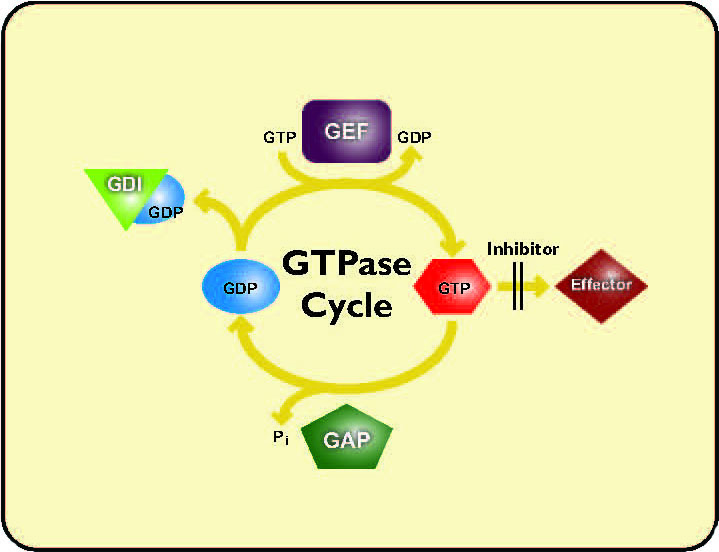Modulator Proteins
Cytoskeleton is the pre-eminent supplier of GAP and GEF proteins. These products contain the active domains and have been fully QC'd for high activity. For more information click on the datasheet below.
Apart from the purified proteins, Cytoskeleton also provides some innovative kits for studying GEFs and GAPs. In particular the Cat. # BK100 kit is useful for measuring GTP or GDP exchange in Rho family members, and it can also be used to study a new GEF or a new GEF/small G-protein combination. The Rho GAP kit, Cat. # BK105, measures the release of phosphate from GTP hydrolysis by a Rho family protein which is accelerated by the GAP protein provided in the kit.

Related Products
For more information view our datasheets below, or contact Technical Support at tservice@cytoskeleton.com .
Cytoskeleton's products have been cited hundreds of times over the past two decades. Please see individual product pages for specific citations or e-mailTechnical Support at tservice@cytoskeleton.com for the latest citations.
RhoGAP Assay Biochem Kit (Cat. # BK105)
Zhang et al., 2010. A Novel Testis-specific GTPase Serves as a Link to Proteasome Biogenesis: Functional Characterization of RhoS/RSA-14-44 in Spermatogenesis. Mol. Biol. Cell. 4312–4324.
Rothenfluh et al., 2006. Distinct Behavioral Responses to Ethanol Are Regulated by Alternate RhoGAP18B Isoforms. Cell. 127, 199–211.
RhoGEF Assay Biochem Kit (Cat. # BK100)
Moey et al., 2011. Ginseng (Panax quinquefolius) attenuates leptin-induced cardiac hypertrophy through inhibition of p115RhoGEF-RhoA/ROCKdependent MAPK pathway activation. J. Pharmacol. Exp. Ther. DOI:10.1124/jpet.111.182600.
Kim et al., 2009. Dipeptidyl Peptidase IV Inhibition With MK0431 Improves Islet Graft Survival in Diabetic NOD Mice Partially via T-Cell Modulation. Diabetes. 58, 641-651.
Li et al., 2009. PLC-gamma1 and Rac1 Coregulate EGF-Induced Cytoskeleton Remodeling and Cell Migration. Mol. Endocrinol. 23, 901-913.
Question 1: What is the best way to measure GEF activity from a cell lysate?
Answer 1: First, the GEF protein must be immunoprecipitated from the cell lysate with either an antibody to the protein or to a tag (His, GST, etc.) that has been conjugated to the protein of interest. After eluting your protein of interest from the beads, the protein’s GEF activity can be measured using Cytoskeleton’s RhoGEF Exchange Assay Biochem Kit (Cat. # BK100). Cytoskeleton Inc. has developed a mant fluorophore-based GEF assay designed for characterizing GEFs and identifying GEF inhibitors. This kit contains human Cdc42 (Cat. # CD01), Rac1 (Cat. # RC01) and RhoA (Cat. # RH01) proteins and the GEF domain of Dbs (Cat. # GE01) as a positive control GEF for Cdc42 and RhoA. The kit also comes with a 384-well and 96-well plate along with exchange buffer that contains the mant-GTP. Once bound to GTPases, the fluorophore emission intensity of mant-GTP increases approximately 1.1 to 2.0 fold depending on the protein. Therefore, the enhancement of fluorescent intensity in the presence of small GTPases and GEFs will reflect the respective GEF activities of known or unknown proteins. We recommend titrating the concentration of your GEF protein to optimize its activity. We suggest a titration range of 0.2-1 uM. Here is a citation that used our GEF assay kit with an immunoprecipitated protein: Kakiashvili et al., 2009. GEF-H1 mediates tumor necrosis factor-alpha-induced Rho activation and myosin phosphorylation: role in the regulation of tubular paracellular permeability. J. Biol. Chem. 284, 11454-11466.
Question 2: How should I prepare my protein for testing in the GAP assay?
Answer 2: All protein samples and buffers must be free of phosphate prior to beginning the RhoGAP assay biochem kit (Cat. # BK105). If your protein is in PBS buffer then it must be dialyzed twice in 1000 volumes of 50 mM PIPES pH 7.0 or 50 mM Tris pH 7.5 buffer to reduce the phosphate content to non-detectable levels. For the assay itself, prepare an 8X concentration of compound in Milli-Q water or for compounds with low solubility in water, use Milli-Q water and 10% DMSO. We recommend a final compound concentration of 30 μM-100 μM for initial screening. A titration of your compound is recommended when performing the GAP assay.
- ARNO GEF Protein (Sec7 Exchange Domain, aa31-267, 6xHis tag) CS-GE07Learn MoreARNO GTP exchange Protein (Sec7 domain)
- Dbs protein GEF domain: His tagged: human recombinant GE01Learn MoreDbs protein GEF domain: His tagged: human recombinant
- PAK-PBD beads (binds active Rac/Cdc42 proteins) PAK02Learn MorePAK-PBD beads (binds active Rac/Cdc42 proteins)
-
-
- RasGRF1 GEF Protein (Cdc25 Exchange Domain, aa1038-1270, MBP tag) CS-GE03Learn MoreRasGRF1 GTP exchange Protein (Cdc25 domain)
-
- Rhotekin-RBD beads (binds active Rho proteins) RT02Learn MoreRhotekin-RBD beads (binds active Rho proteins)
- Rhotekin-RBD protein (binds active Rho proteins) RT01Learn MoreRhotekin-RBD protein (binds active Rho proteins)
- SOS1 Protein (ExD Exchange Domain, aa564-1049, 6xHis tag) GE02Learn MoreSOS1 Protein (ExD Exchange Domain, aa564-1049)
- Tiam1 GEF Protein (DHPH Exchange Domain, aa1040-1406, MBP tag) CS-GE04Learn MoreTiam1 GTP exchange Protein (DHPH domain)
- Vav1 GEF Protein (DHPHC1 Exchange Domain, Y174D mutant, aa168-522, 6xHis tag) CS-GE05Learn MoreVav1 GTP exchange Protein (DHPHC1 domain)
- Vav2 GEF Protein (DH Exchange Domain, aa189-374, 6xHis tag) CS-GE06Learn MoreVav2 GTP exchange Protein (DH domain)
